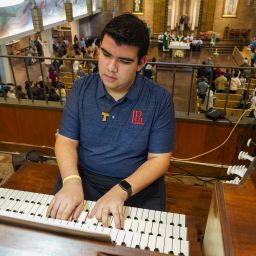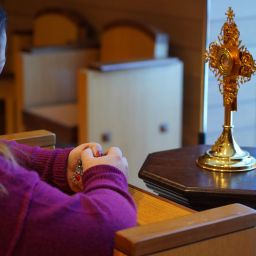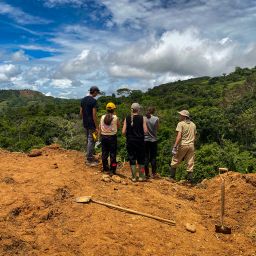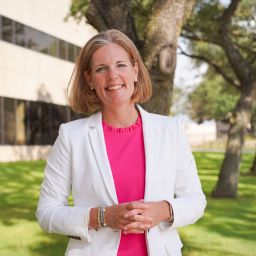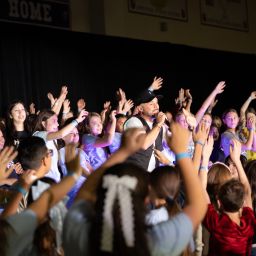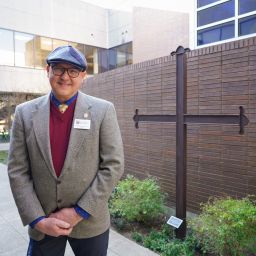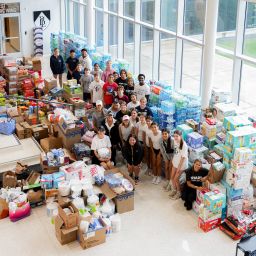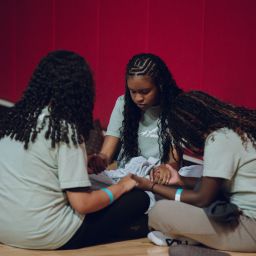
By Michelle Johnson
Special to The Texas Catholic
A group of students at John Paul II High School’s Social Innovation Lab is exploring how to build strong communities in a digital age while remaining rooted in the Catholic Church’s teachings. Their efforts have earned the lab one of only 17 invitations nationwide to a program at The University of Notre Dame.
The Church Communications Ecology Program (CCEP) is a six-month educational formation program for leaders charged with helping their communities thrive in the digital age. In its second year, the program was designed to help Catholic Church leaders confront the social and psychological effects of technological change on the Church and culture. Young people are some of the primary drivers of technology, a fact that JP II faculty and staff has embraced and encouraged with students.
“A big thing for us in our leadership team has been trying to integrate our ‘Catholicity’ with innovation,” said Sean Whitten, director of communications and marketing at JPII. “The project we are doing is using it to solve some of the negative pieces of being digital natives and how our Catholic identity helps us do that. In the church we are supposed to be good citizens and we have that value; this is how we move from the printing press to the digital community.”
The lab opened in 2018 to offer junior and senior students a way to live out the vision of Catholic Social Teaching to make the world more humane, more just, more effective, and more sustainable. Students do this through hands-on education, community engagement and Catholic identity with social entrepreneurs. But pandemics tend to put a damper on community outreach.
“Because of COVID, it puts some constraints on us being able to partner with outside organizations as we have in the past,” said Frank Santoni, director of the lab. “This year the community partner was the school. The issues of social media usage, cyber bullying, were viewed as timely and we thought could be a good use of the lab’s energies.”
This is not the first recognition the lab has received in its young existence. In 2019, three JPII students were invited to present their design project on teen food insecurity at the first annual I CAN Global Children’s Summit in Rome, Italy, hear an address from Pope Francis, and collaborate with peers on solving social issues.
Santoni will serve on a cohort of Church leaders as part of the university-sponsored program, now in its second year. He will be joined by Melissa Downs, dean of innovation and academic programs at JPII. The cohort of Church leaders includes executives, educators, media professionals and seminarians. JPII’s participation marks the only one that considers students as an extension of the cohort representative.
The CCEP participants take part in a six-week online course with theology, philosophy and communications faculty from Notre Dame and Mount Saint Mary’s University. An immersive workshop will be held in April in Pittsburgh, where participants will visit the Carnegie Mellon Argo AI Center, the Andy Warhol Museum and the Fred Rogers Center for Early Learning and Children’s Media at Saint Vincent College. The program culminates in June at Notre Dame, where leaders will share their transformational ideas with their peers and faculty. Santoni said he hopes the JPII students’ ideas will create a lasting impact on student digital communities schoolwide for years to come.
“We hope we can discover how to approach the topic of social media usage in ways that are relevant to students and are effective in improving the positive engagement of social media,” Santoni said. “We start the school year with a section on Catholic social principles and God’s grander vision for the world. Then we look for ways to increase that grace and human dignity.”
The lab is a two-semester commitment for students, who are selected by faculty members identifying qualities particularly suited for the lab.
In the fall, through site visits, guest speakers and direct service, students learn about the complex social issues that affect the community. In the spring, work with a local non-profit in teams, coached by mentors, to apply the techniques they have learned.
“The staff reaches out to teachers to identify students who are extra curious, tenacious, who put their curiosity to action and have the initiative piece,” Whitten said. “Running throughout the design thinking process in the lab itself, as they ideate and test those things forward, they put out key performance indicators of their work. It is student led. They are evangelizing the message throughout the student community, they are running social experiments, they have come in and interviewed the staff. They want to show that community can be built in a healthy manner for adolescents at large on a digital platform.”
Lab students are grouped into four teams, each working on different potential embodiments of the project. One of these prototypes could ultimately extend into the 2022-2023 school year in an implementation phase. Santoni said some examples include looking at how to help students behave more positively and make better comments on each other’s posts; how to give students experiences at school that help connect them and meet new people; and how to encourage productivity when social media can be such a distraction.
“It might be a social media campaign, a new club, or a peer-to-peer seminar,” Santoni said. “But they have to start by doing the research. They have probably spent 50 hours talking to peers about their digital experiences, listening for opportunities where innovation could help.
The students will present their projects at the end of the school year and it could be that one of those projects we take to the June workshop and work on it and possibly implement it next school year.”
For the centuries-old Catholic Church, a groundswell of students leading the faithful into this digital age is a sign that Catholic values can coexist with social media, Whitten said. While student behavior on social media is regulated in the school’s handbook, there are still pockets of negativity.
“The conflict, generally speaking, is between our digital native – the student – and the Catholic Church,” he said. “There is cyber bullying, and for a lot of our kids, their initial engagement has been how to solve that problem with a Catholic lens. The lab encourages broadening that question with them. They have hybrid coursework online, but the question is how are you going to be able to build community as you move forward. Students are in class groups on Instagram and clubs. We have social media guidelines in our handbook. We are a 24-7 school, they are fully aware of that from day one. We would shift our purvey if they were to create something through this program. They could be ideating a benefit for the school as well as the at-large community of Collin County. After all, the school’s motto is ‘Seek to Serve.’”
Discover more information about the lab at Social Innovation Lab.


